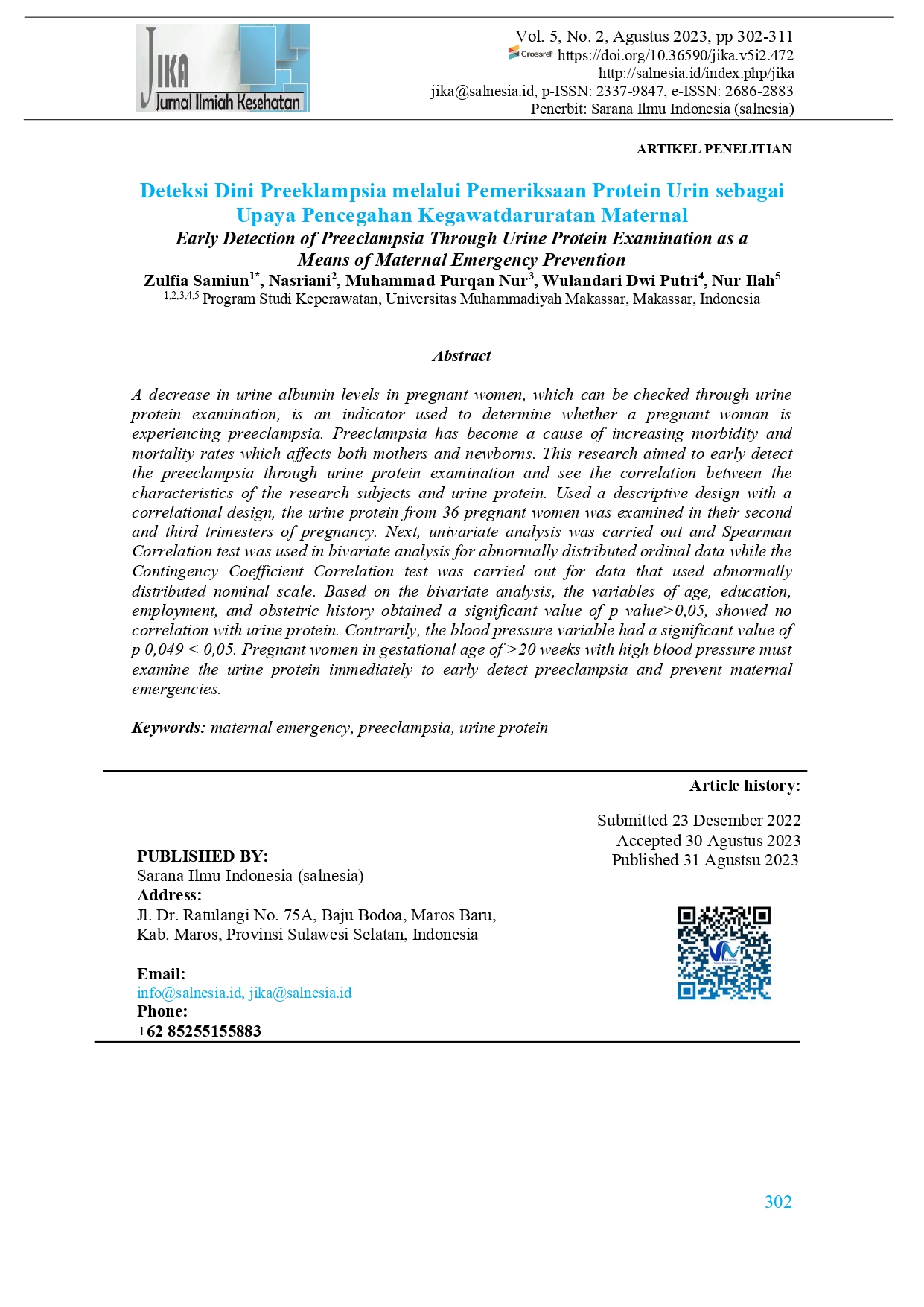Early Detection of Preeclampsia Through Urine Protein Examination as a Means of Maternal Emergency Prevention
DOI:
https://doi.org/10.36590/jika.v5i2.472Keywords:
maternal emergency, preeclampsia, urine proteinAbstract
A decrease in urine albumin levels in pregnant women, which can be checked through urine protein examination, is an indicator used to determine whether a pregnant woman is experiencing preeclampsia. Preeclampsia has become a cause of increasing morbidity and mortality rates which affects both mothers and newborns. This research aimed to early detect the preeclampsia through urine protein examination and see the correlation between the characteristics of the research subjects and urine protein. Used a descriptive design with a correlational design, the urine protein from 36 pregnant women was examined in their second and third trimesters of pregnancy. Next, univariate analysis was carried out and Spearman Correlation test was used in bivariate analysis for abnormally distributed ordinal data while the Contingency Coefficient Correlation test was carried out for data that used abnormally distributed nominal scale. Based on the bivariate analysis, the variables of age, education, employment, and obstetric history obtained a significant value of p value>0,05, showed no correlation with urine protein. Contrarily, the blood pressure variable had a significant value of p 0,049 < 0,05. Pregnant women in gestational age of >20 weeks with high blood pressure must examine the urine protein immediately to early detect preeclampsia and prevent maternal emergencies.
Downloads
References
Aldika Akbar, MI, Bachnas MA, Mose JC, Dachlan EG, Ernawat E, Dekker GA, … Kristanto H.2018. The Massive Problem of Preeclampsia in Indonesia?: In Need of a Redesigned National Health Care System. Pregnancy Hypertension, 13: S16 https://doi.org/10.1016/j.preghy.2018.08.051.
Cui Lifeng, et al. 2018. Serum Protein Marker Panel for Predicting Preeclamsia. Pregnancy Hypertension, 14: 279-285. https://doi.org/10.1016/j.preghy.2018.01.009
Gynecologists. 2020. Gestational Hypertension and Preeclampsia. Woltters Kluwer Health, 134(6): 237-260. https://doi.org/10.1097/AOG.0000000000003891.
Hariyanti, Mutaqin Z, Marlina ED. 2021. Kenali Preeklampsia Sejak Dini. Purwokerto Barat: Zahira Media Publisher.
Khayati YN, Veftisia V. 2018. Hubungan Stress dan Pekerjaan dengan Preeklampsia di Wilayah Kabupaten Semarang. Indonesian Journal of Midwifery, 1(1): 35-40. https://doi.org/10.35473/ijm.v1i1.38.
Masruroh, N and Santoso Andreas PR. 2020. Hubungan Protein Urine dan Mean Arteri Pressure dengan Kejadian Hipertensi pada Ibu Hamil Trimester III di RSU Prima Husada Sidoarjo. Jurnal Kebidanan Kestra, 3(1): 48–54. https://doi.org/10.35451/jkk.v3i1.479.
Merta Wayan. 2017. Kadar Protein Urin pada Ibu Hamil Trimester II dan III di Puskesmas II Denpasar Barat. The Journal of Medical Laboratory, 5(1): 31–44. https://doi.org/10.33992/m.v5i1.108.
Ni’mah M. 2017. Gambaran Kadar Hemoglobin dan Protein pada Ibu Hamil Trimester III di Rumah Bersalin Mattiro Baji GOWA. [Skripsi]. Makassar: Universitas Islam Negeri Alauddin Makassar.
Nurmainah N, Hadad FM, Andrie M. 2021. Profil Proteinuria dan Tekanan Darah pada Pasien Preeklampsia Berat yang menggunakan Antihipertensi. Indonesian Journal of Clinical Pharmacy, 10(2): 79-89. https://doi.org/10.15416/ijcp.2021.10.2.79.
POGI. 2016. Pedoman Nasional Pelayanan Kedokteran (PNPK): Ketuban Pecah Dini. Indonesia: Himpunan Kedokteran Feto Maternal.
Riani EN and Ambarwati D. 2020. Deteksi Dini Protein Urin sebagai Upaya Pencegahan Preeklampsia. Seminar Nasional LPPM, 88–90.
Setiawati Iin and Lailiyah SR. 2020. Deteksi Dini Preeklamsi pada Ibu Hamil dengan Penimbangan Berat Badan dan Pengukuran Tekanan Darah. Jurnal Pemberdayaan dan Pengabdian Kepada Masyarakat, 2(1): 17-27.
Setyawan JFD, Wiryanthini AUD, Tianing NW. 2019. Gambaran Kadar Protein Urine pada Ibu Hamil Preeklampsia dan Eklamsia di RSUP Sanglah Denpasar. Jurnal Medika Udayana, 8(2): 1-5.
Silvana R, Ramayanti I, Kurniawan, Dimar Ramadhina A. 2023. Hubungan antara Usia Ibu, Status Gravida, dan Riwayat Hipertensi dengan Terjadinya Preeklampsia. Jurnal Ilmiah Multidisiplin, 2(4): 1370–1375.
Situmorang TH, Damantalm Y, Januarista A, and Sukri. 2016. Faktor-Faktor yang Berhubungan dengan Kejadian Preeklampsia pada Ibu Hamil di Poli KIA RSU Anutapura Palu. Jurnal Kesehatan Tadulako, 2(1): 34-44.
Stefanska K, et al. 2020). Comparisons of Dipstick Test, Urine Protein-to-Creatine Ratio, and Total Protein Measurement for the Diagnosis of Preeclampsia. International Journal of Environmental Research and Public Health, 17(12): 1-9. https://doi.org/10.3390/ijerph17124195.
Veftisia V, Nur Khayati Y. 2018. Hubungan Paritas dan Pendidikan Ibu Dengan Kejadian Preeklampsia Di Wilayah Kabupaten Semarang. Siklus?: Journal Research Midwifery Politeknik Tegal, 7(2): 336-340. https://doi.org/10.30591/siklus.v7i2.830.
Yudia Gustri, Rico Januar Sitorus FU. 2016. Determinan Kejadian Preeklampsia pada Ibu Hamil di RSUP Dr. Mohammad Hoesin Paelmbang. Journal Midwifery Jurusan Kebidanan Politeknik Kesehatan Gorontalo, 7(1): 32-43. https://doi.org/10.52365/jm.v7i1.318.
Yuliani DR, Hastuti P. 2019. Hubungan Jarak Kehamilan Dengan Tekanan Darah Ibu Hamil Preeklampsia. Jurnal Sains Kebidanan, 1(1): 7–11. https://doi.org/10.31983/jsk.v1i1.5436.

Downloads
Published
How to Cite
Issue
Section
License
Copyright (c) 2023 Zulfia Samiun, Nasriani, Muhammad Purqan Nur, Wulandari Dwi Putri, Nur Ilah

This work is licensed under a Creative Commons Attribution 4.0 International License.








